Forum on trading, automated trading systems and testing trading strategies
newdigital, 2014.06.15 17:18
Forex Fundamentals - Weekly outlook: June 16 - 20The dollar ended Friday’s session flat against a basket of other major currencies as escalating tensions in Iraq underpinned safe haven demand for the greenback, offsetting an unexpected decline in U.S. consumer confidence.
Concerns over the ongoing Sunni insurgency in Iraq hit market sentiment on Friday, after insurgents took control of the Iraqi cities Mosul and Tikrit, fuelling fears over the impact of reduced oil supply on global growth.
The escalating violence in Iraq overshadowed a report showing that U.S. consumer sentiment unexpectedly deteriorated in June.
The preliminary reading of the University of Michigan's consumer sentiment index for June came in at 81.2, down from 81.9 in May, missing expectations for an uptick to 83.0.
The US Dollar Index, which tracks the performance of the greenback versus a basket of six other major currencies, was flat at 80.75 late Friday.
The dollar was higher against the yen, with USD/JPY up 0.28% to 101.99 late Friday. For the week, the pair was down 0.49%.
The euro edged lower against the dollar, with EUR/USD dipping 0.08% to 1.3541 at the close, not far from the four-month trough of 1.3502 reached on June 5. For the week, the pair lost 0.38%.
The single currency has weakened broadly since the European Central Bank cut rates to record lows earlier this month, in order to combat the threat of persistently low inflation in the euro area.
Elsewhere, the pound ended the week close to five year highs against the dollar after Bank of England Governor Mark Carney said Thursday that U.K. interest rates could rise sooner than investors expect.
GBP/USD was up 0.24% to 1.6968 late Friday, after rising as high as 1.6990 earlier in the session, the most in almost five years. The pair ended the week with gains of 0.99%.
Sterling rose to one-and-a-half year highs against the broadly weaker euro, with EUR/GBP down 0.30% to 0.7981 late Friday, extending the week’s losses to 1.32%.
The New Zealand dollar turned lower on Friday amid increased safe haven demand, with NZD/USD slipping 0.26% to 0.8663.
The pair rallied to a one month high of 0.8699 Thursday after the Reserve Bank raised its benchmark interest rate to a five-year high of 3.25% and indicated that borrowing costs would rise again as strong economic growth fuels inflation pressures.
In the week ahead, investors will be focusing on the outcome of Wednesday’s Federal Reserve policy meeting, while Monday’s preliminary report on euro zone inflation will also be closely watched.
Ahead of the coming week, Investing.com has compiled a list of these and other significant events likely to affect the markets.
Monday, June 16
- The euro zone is to release preliminary data on consumer price inflation, which accounts for the majority of overall inflation.
- Canada is to publish a report on foreign securities purchases.
- The U.S. is to produce data on industrial production and manufacturing activity in the Empire State.
- The Reserve Bank of Australia is to publish the minutes of its latest policy meeting, which contain valuable insights into economic conditions from the bank’s perspective.
- Switzerland is to release data on producer price inflation, while the U.K. is to release data on consumer price inflation.
- The ZEW Institute is to release its closely watched report on German economic sentiment, a leading indicator of economic health.
- Later Tuesday, the U.S. is to produce data on housing starts, building permits and consumer prices.
- New Zealand is to release data on the current account, while Australia is to publish an index of leading economic indicators.
- The Bank of Japan is to publish the minutes of its latest policy meeting, which contain valuable insights into economic conditions from the bank’s perspective. Japan is also to release data on the trade balance.
- The BoE is to publish the minutes of its latest policy setting meeting.
- The ZEW Institute is to publish a report on economic expectations in Switzerland, a leading indicator of economic health.
- Canada is to produce data on wholesale sales.
- Later Wednesday, the Federal Reserve is to announce its federal funds rate and publish its rate statement. The announcement is to be followed by a press conference with Fed Chair Janet Yellen.
- New Zealand is to publish data on gross domestic product, the broadest indicator of economic activity and the leading measure of the economy’s health.
- The Swiss National Bank is to announce its libor rate. The bank is also to publish its quarterly monetary policy assessment and hold a press conference.
- The U.K. is to release data on retail sales, the government measure of consumer spending, which accounts for the majority of overall economic activity.
- The Eurogroup of euro area finance ministers are to hold meeting in Brussels.
- The U.S. is to publish the weekly report on initial jobless claims as well as a report on manufacturing activity in the Philadelphia region.
- Germany is to publish data on producer price inflation.
- BoJ Governor Haruhiko Kuroda is to speak at an event in Tokyo; his comments will be closely watched.
- The euro zone is to release data on the current account, while the euro area’s Economic and Financial Affairs Council is to hold meetings in Brussels.
- The U.K. is to release data on public sector net borrowing.
- Canada is to round up the week with data on consumer inflation and retail sales.
Forum on trading, automated trading systems and testing trading strategies
newdigital, 2014.06.13 21:41
Forex Fundamentals Weekly Outlook June 16-20The dollar and the euro were on the back foot in the past week. The focus is now on the Fed decision and the UK inflation data. In addition, the Philly Fed Manufacturing Index and inflation figures will be of interest. Here are the main events on our FX calendar. Here is an outlook on the market-movers for the coming week. A jump in US job openings underpinned the US dollar. While this figure is lagging, it closely watched by the Federal Reserve. However, other figures from the US, such as retail sales, were mediocre. The UK enjoyed encouraging employment figures that lift the prospects of an early rate hike, and Carney indeed explicitly said that a rate hike make come sooner than later, sending the pound jumping up.. In Europe, the lower bond yields and the implementation of the negative deposit rate weighed on the common currency. Another currency that stood out is the kiwi that leaped up: the RBNZ hiked the rate and did not signal a pause.
- UK inflation data: Tuesday, 8:30. Annual inflation in the UK edged up to 1.8% in April, rising for the first time in almost a year, following 1.6% in the previous month. The main cause for this rise was higher travel and energy prices. Analysts expected a smaller climb of 0.1%. However rising inflation ignites new fears that the standard of living will decline due to falling wages. CPI is expected to slide to an annual level of 1.7%. The RPI is predicted to remain at 2.5% and Core CPI to slide to 1.7%.
- German ZEW Economic Sentiment: Tuesday, 9:00. German economic sentiment plunged in May by 10.1 points, to 33.1, hitting the lowest level since January 2013. The Ukraine crisis was the probable cause for this fall starting effect economic activity, especially in the eastern part of the country. Economists expected a 2.2 points fall to 41.3 in May. A rise to 35.2 points is expected now. The all-European figure is also expected to advance to 59.6 points.
- US Building Permits: Tuesday, 12:30. U.S. building permits soared in April to their highest level in nearly six years, reaching 1.08 million-unit pace. The sharp rise offered hope that the recent sluggishness in the housing market may be over. The 90,000 rise surprised analysts expecting a 1.01 million-unit pace. A similar level of 1.07 million is estimated now. Housing starts carry expectations of dropping from 1.07 to 1.04 million.
- US inflation data: Tuesday, 12:30. U.S. Consumer Price Index increased 0.3% in April after posting a 0.2% gain in March, as food prices edged up for a fourth consecutive month and the cost of gasoline climbed. The reading was consistent with analysts’ forecast. In the 12 months through April, CPI gained 2.0% after a 1.5% rise in March, the biggest increase since July last year. Meanwhile, core inflation, excluding food and energy prices, rose 0.2% above predictions of a 0.1% rise and following a 0.2% rate in the previous month. US inflation remains in Goldilocks territory. Both CPI and Core CPI are expected to rise 0.2% m/m.
- UK MPC Meeting Minutes: Wednesday, 8:30. After Carney lifted the pound with his rate hike comment, it will be very interesting to see if one or more members already voted for a rate hike in June’s no-change decision. Up to now, Carney enjoyed unanimous support behind his policy, and that is what is expected now. A non-unanimous vote could push the pound even higher.
- US rate decision: Wednesday, 18:00, press conference at 18:30. The Fed is expected to taper bond buys for the 5th time, to $35 billion / month. Recent data from the US has been positive and showed growth in jobs as well as in other sectors after the terrible first quarter. Markets will likely focus on the fresh economic projections, especially those concerning the potential date of a rate hike. The previous decision was not accompanied by a press conference, and it passed quite quietly. This was not the case in March, when Yellen said that a rate hike could come within 6 months of the end of QE and stirred markets. Was it a slip in her first appearance or did she sow the initial seed for a rate hike in early 2015? Every word she says now will be scrutinized and could cause a significant market stir. Given the recent improvement, we can expect a more hawkish approach. If the hints are subtle, a full response to the FOMC statement and the press conference can only be expected in the following sessions. Contrary to April’s decision, this one could have a long lasting impact on markets.
- NZ GDP: Wednesday, 22:45. Economic growth in New Zealand continued to grow in the last quarter of 2013, rising 0.9% from a 1.2% expansion in the third quarter. Analysts expected a higher rise of 1.0% in the 4th quarter. Manufacturing and wholesale trade were the main contributors to the rise in output. On an annualized rate, GDP expanded 3.1% in the December quarter, in line with forecasts. A growth rate of 1.2% is expected now.
- Switzerland rate decision: Thursday, 7:30. The Swiss National Bank kept rates unchanged at 0.25% but was more optimistic on future growth prospects. The bank reiterated its commitment to defend the 1.20 per euro limit with unlimited interventions and stood ready to take further measures if necessary. The SNB said economic activity in Switzerland should improve from the first quarter of 2014 confirming a 2.0% growth this year.
- US Unemployment Claims: Thursday, 12:30. Recent trends in jobless claims have been positive, with a gradual convergence towards the 300K level. While the drops have never been steady, the US job market seems to be going in the right direction. A figure of under 300K will certainly be dollar positive, but after the recent rise to 317K, a similar value of 316K is predicted.
- US Philly Fed Manufacturing Index: Thursday, 14:00. US manufacturing barometer in the Philadelphia area declined less than expected in April, reaching 15.4 after rising to 16.6 points in March. The Philly Fed’s general conditions index reaching 15.4 in May was nearly as strong as April’s 16.6. This report, together with Empire State, reaffirms the strength of the US manufacturing sector. A small slide to 14.3 points is on the cards.
Forum on trading, automated trading systems and testing trading strategies
newdigital, 2014.06.16 12:40
The ECB (European Central Bank) introduced a huge package of measures to inspire economic growth. EURUSD stays under pressure in the medium term, but could rebound to 1.37 short-term.
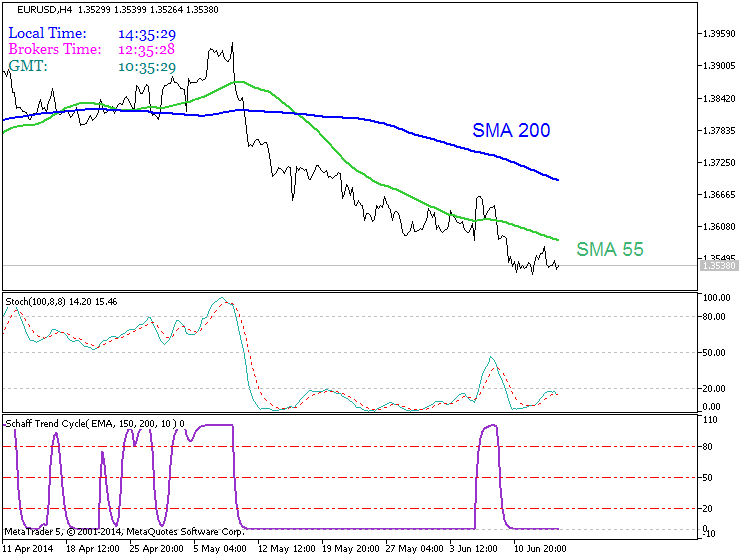
ECB: Timing the economy
After months of expectation, the European Central Bank has presented a huge package of measures aimed at boosting the anemic economic growth of the Eurozone and increasing inflation. The ECB cut interest rates to its lowest level ever to 0.15% and introduced a negative deposit rate of -0.10%. In addition, it will end the so called “sterilization tender,” which should increase money market liquidity by more than 150 billion euros. The ECB will also provide banks with any liquidity needed against collateral until the end of 2016. Finally, it might soon announce the purchase of ABS (asset-backed securities). It appears clear that Mr. Draghi considers the current time to be crucial. He does not, however, disregard the introduction of quantitative easing in the future—particularly if inflation were to decline during the summer. The news eased sovereign debt yields in Italy and Spain with the Italian hitting an historical low of 2.75%. EURUSD could stay under pressure over the medium term; however, in the short term, it might rebound to 1.37. The market is oversold. Funds are extremely short for EURUSD, and seasonal conditions support a rebound in the second half of the year.
US: The economy is still trending
Last
week, the ISM Index confirmed the US economy is still performing well.
The Production Index showed the widest movement reaching 61 (+5.3) and
attesting that the winter weakness was only temporary. In fact, new
orders rose to almost 57, and deliveries face challenges meeting the
strong demand. The employment component, on the other hand, fell to
52.8. However, this increased in the manufacturing survey. Overall, US
employment has performed nicely, but job creations fell to 217,000 in
May. On an annual basis, the number is 281,000 versus 264,000 in 2013.
The unemployment rate remained stable at 6.3%, but there is still a
large number of part-time workers wanting to work fulltime. This
represents 46% of the labor force as compared to 20% in the first half
of 2000 for those not able to find work. The Job Openings and Labor
Turnover Survey data for April offered a brighter picture and showed
there were more than 4 million job openings, which is not too far from
the peak of 4.6 million registered before the housing slump.
Nonetheless, hiring improved only mildly, increasing by 2,000 people
from the previous month. On the contrary, layoffs are at their lowest
level since the index was created in 2000. The study of cycles still
anticipates unemployment numbers to bottom out sometime in 2014/15 and
then increase again for the last wave.
Forum on trading, automated trading systems and testing trading strategies
newdigital, 2014.06.14 16:10
EURUSD Fundamentals (based on dailyfx article)
Fundamental Forecast for Euro: Neutral- Euro seems likely to hold in tight range as long as this level doesn’t give way
- One-sided retail crowd positions versus the US Dollar and Japanese Yen warn of bounce
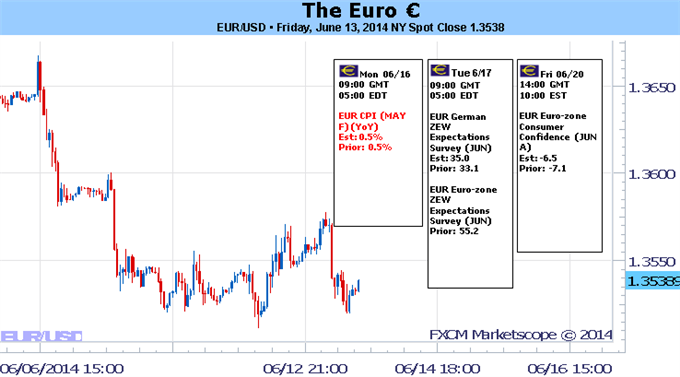
The Euro finished near four-month lows versus the Dollar, but the lack
of volatility in recent markets makes it unlikely it breaks
significantly lower. We’re watching key event risk for a potential
breakdown.
A relatively empty European economic calendar leaves focus on the upcoming US Federal Open Market Committee meeting, and any surprises from the Fed could force major USD pairs out of their recent trading ranges.
It’s almost a given that the FOMC will taper their Quantitative Easing
purchases by a further $10 billion through their decision. Thus
instead of the actual decision traders will focus on official
statements, changes in Fed inflation and growth forecasts, and the
press conference to follow the announcement. Of particular interest is
whether the Committee hints at the timing of future interest rate
hikes.
Interest rates are especially important for the Euro as traders have
sent it to multi-month lows on the widely-expected European Central
Bank rate cuts. The fact that the US Federal Reserve is headed in the
opposite direction helps explain why the EURUSD trades near key lows.
Yet clear uncertainty in Fed forecasts leaves ample room for
disappointment and potential for Euro volatility.
Any major FOMC surprises could ultimately force the Euro out of its
recent range versus the Dollar. Yet FX options markets show volatility
prices continue to trade near record-lows, and recent price action
offers few clues on when volatility might return. Even a sharp two-day
sell-off in the US S&P 500 and broader global equities wasn’t enough
to drive the safe-haven US Dollar above key resistance versus the Euro.
The lack of volatility and conviction thus keeps us focused on buying
the Euro near support, selling near resistance. Our Senior Strategist
warns that a close below $1.3520 could spark a larger decline, but
until then watch for the Euro to remain in a tight range versus the
Greenback.
Forum on trading, automated trading systems and testing trading strategies
newdigital, 2014.06.14 18:33
EUR/USD forecast for the week of June 16, 2014, Technical AnalysisThe EUR/USD pair spent most of the week falling, and tested the 1.35 level for support. Because of this, we think that the area will be targeted, and if we can break below there on a daily close, this market could fall apart. The Euro would fall to the 1.33 level as far as we can tell, and would be a sell. However, this area has been fairly resilient so we are quite ready to start selling yet. The bounce could happen, and we could stay within the fairly tight range that we have been in for the last month.
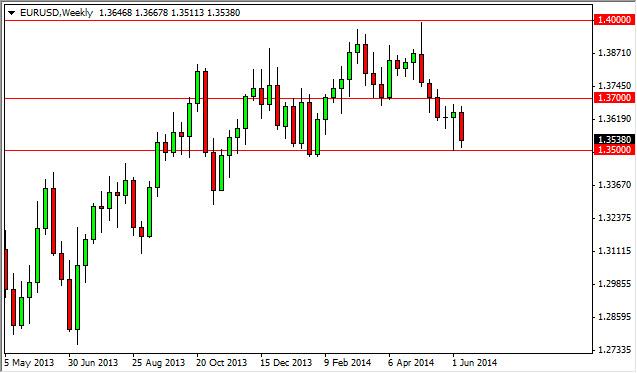
Forum on trading, automated trading systems and testing trading strategies
newdigital, 2014.06.17 15:00
2014-06-17 12:30 GMT (or 14:30 MQ MT5 time) | [USD - CPI]
- past data is 0.3%
- forecast data is 0.2%
- actual data is 0.4% according to the latest press release
if actual > forecast = good for currency (for USD in our case)
[USD - CPI] = Change in the price of goods and services purchased by consumers. Consumer prices account for a majority of overall inflation. Inflation is important to currency valuation because rising prices lead the central bank to raise interest rates out of respect for their inflation containment mandate.
==========
U.S. Consumer Prices Rise More Than Expected In May
Consumer prices rose by more than expected in the month of May, according to a report released by the Labor Department on Tuesday, with the increase reflecting broad-based price growth.
The Labor Department said its consumer price index rose by 0.4 percent in May after climbing by 0.3 percent in April. Economists had expected the index to edge up by about 0.2 percent.
Core consumer prices, which exclude food and energy prices, increased by 0.3 percent in May after rising by 0.2 percent in the previous month. Core prices had also been expected to tick up by 0.2 percent.
MetaTrader Trading Platform Screenshots
MetaQuotes Software Corp., MetaTrader 5, Demo
EURUSD M5 : 33 pips price movement by USD - CPI news event

Forum on trading, automated trading systems and testing trading strategies
newdigital, 2014.06.15 17:29
EUR/USD Fundamentals - weekly outlook: June 16 - 20The broadly weaker euro slid lower against the dollar on Friday, re-approaching four-month lows as concerns over the escalating conflict in Iraq bolstered safe haven demand for the dollar.
EUR/USD was down 0.08% to 1.3541 at the close, not far from the four-month trough of 1.3502 reached on June 5. For the week, the pair lost 0.38%.
The pair is likely to find support at the 1.3500 level and resistance at 1.3601, the high of June 10.
The single currency has weakened broadly since the European Central Bank cut rates to record lows earlier this month, in order to combat the threat of persistently low inflation in the euro area.
Concerns over the ongoing Sunni insurgency in Iraq hit market sentiment on Friday, amid fears over the impact of reduced oil supply from one of the world’s largest producers on global economic growth.
The dollar was little changed after a report showed that U.S. consumer sentiment unexpectedly deteriorated in June.
The preliminary reading of the University of Michigan's consumer sentiment index for June came in at 81.2, down from 81.9 in May, missing expectations for an uptick to 83.0.
Elsewhere Friday, the euro slumped to one-and-a-half year lows against the stronger pound, with EUR/GBP down 0.30% to 0.7981 late Friday, extending the week’s losses to 1.32%.
Sterling strengthened broadly after Bank of England Governor Mark Carney said on Thursday that U.K. interest rates could rise sooner than investors expect.
The euro edged higher against the yen, with EUR/JPY rising 0.26% to 138.18, not far from the four month low of 137.71 struck in the previous session. For the week, the pair lost 0.81%.
In the week ahead, investors will be focusing on the outcome of Wednesday’s Federal Reserve policy meeting, while Monday’s preliminary report on euro zone inflation will also be closely watched.
Ahead of the coming week, Investing.com has compiled a list of these and other significant events likely to affect the markets.
Monday, June 16
- The euro zone is to release preliminary data on consumer price inflation, which accounts for the majority of overall inflation.
- The U.S. is to produce data on industrial production and manufacturing activity in the Empire State.
- The ZEW Institute is to release its closely watched report on German economic sentiment, a leading indicator of economic health.
- Later Tuesday, the U.S. is to produce data on housing starts, building permits and consumer prices.
- The Federal Reserve is to announce its federal funds rate and publish its rate statement. The announcement is to be followed by a press conference with Fed Chair Janet Yellen.
- The Eurogroup of euro area finance ministers are to hold meeting in Brussels.
- The U.S. is to publish the weekly report on initial jobless claims as well as a report on manufacturing activity in the Philadelphia region.
- Germany is to publish data on producer price inflation.
- The euro zone is to release data on the current account, while the euro area’s Economic and Financial Affairs Council is to hold meetings in Brussels.
Forum on trading, automated trading systems and testing trading strategies
newdigital, 2014.06.18 08:23
EUR/USD Technical Analysis – Looking for Drivers Above 1.35 (adapted from dailyfx article)
- EUR/USD Technical Strategy: Pending Short
- Support: 1.3476-1.3502 (Feb 3 low, Jun 5 low)
-
Resistance:1.3574-85 (14.6% Fib ret., May 29 low), 1.3618 (23.6% Fib ret.)
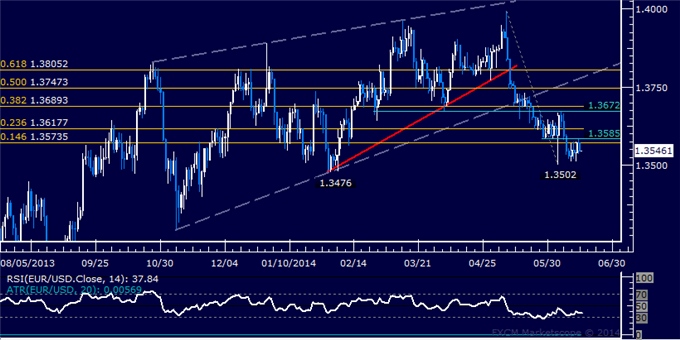
The Euro is treading water as prices digest recent losses against the US Dollar
that brought the pair to a four-month low. Near-term support is seen in
the 1.3476-1.3502 zone, an area bracketed by lows from June 5 and
February 3. Initial resistance is in the 1.3574-85 area, marked by the
May 29 low and the 14.6% Fibonacci expansion. A break above that on a
daily closing basis opens the door for a challenge of the 23.6% level at
1.3618.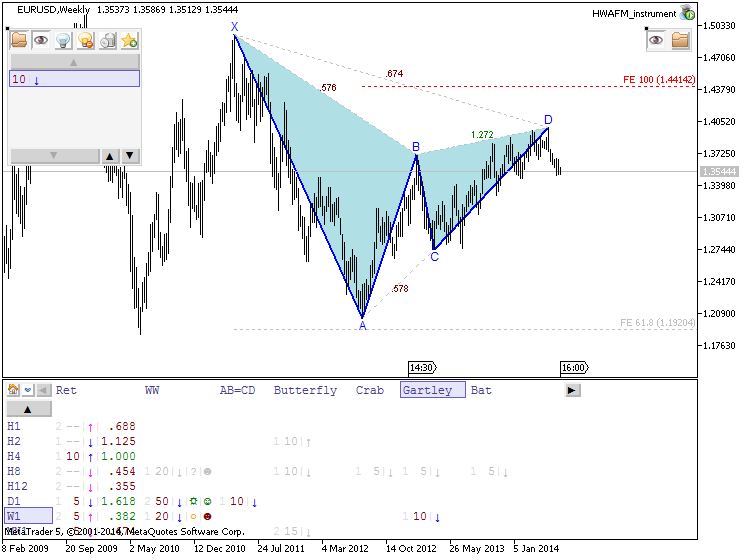

The Euro started this week fairly energetic, but the weekly PP coupled with the 20-day SMA turned out to be enough to prevent the pair from realising its ambitions. Accordingly, the rate may soon re-test the support at 1.3481/75 (monthly S1 and 2014 low), as suggested by the daily technical indicators. And even though on the monthly chart the studies are mostly giving ‘buy’ signals, as long as a down-trend at 1.39 is intact, the overall outlook will remain bearish. onestopbrokers

- 2014.06.18
- OneStopBrokers
- www.onestopbrokers.com
Forum on trading, automated trading systems and testing trading strategies
newdigital, 2014.06.18 14:29
Trading the News: Federal Open Market Committee Meeting and Federal Funds Rate (based on dailyfx article)
- Federal Open Market Committee (FOMC) to Reduce QE by Another $10B.
- Fed Chair Janet Yellen to Hold Press Conference at 18:30 GMT.
Despite expectations for another $10B reduction in the Federal Open
Market Committee’s (FOMC) asset-purchase program, the central bank’s
updated forecasts (growth, inflation & interest rate) may have a
greater impact in driving the U.S. dollar as market participants weigh
the outlook for monetary policy.
What’s Expected:

Why Is This Event Important:
Indeed, there’s limited scope of seeing a material shift in the Fed’s
policy outlook as Chair Janet Yellen remains reluctant to normalize
monetary policy, and the interest rate decision may spur a bearish
dollar reaction (bullish EUR/USD) should we get more of the same from
the central bank.
Sticky inflation paired with the ongoing improvement in the labor market
may encourage the FOMC to soft its dovish tone for monetary policy, and
the fresh developments coming out of the central bank may generate a bullish outlook for the dollar should we see a greater dissent within the committee.
However, the slowdown in the housing market along with the dismal 1Q GDP
reading may push the FOMC to lower its fundamental projections for the
U.S. economy, and the updated forecasts may heighten the bearish
sentiment surrounding the greenback should the calculations drag on
interest rate expectations.
How To Trade This Event Risk
Bullish USD Trade: FOMC Cuts Another $10B & Shows Greater Willingness to Normalize
- Need red, five-minute candle following the release to consider a short EUR/USD trade
- If market reaction favors a long dollar trade, short EUR/USD with two separate position
- Place stop at the near-by swing high/reasonable distance from entry; look for at least 1:1 risk-to-reward
- Move stop to entry on remaining position once initial target is hit, set reasonable limit
- Need green, five-minute candle to favor a long EUR/USD trade
- Implement same setup as the bullish dollar trade, just in opposite direction
EUR/USD Daily
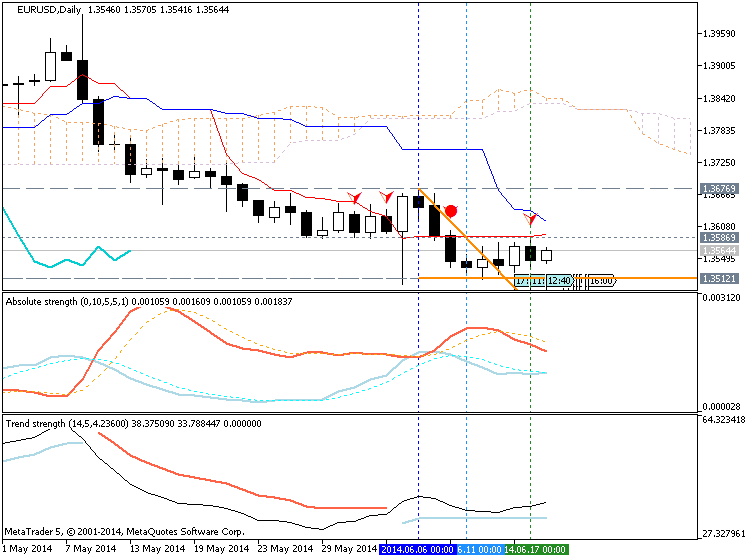
- Sideways Price Action in Focus as EUR/USD Holds Monthly Range
- Interim Resistance: 1.3650 (78.6% expansion) to 1.3670 (61.8% retracement)
- Interim Support: 1.3490 (50.0% retracement to 1.3500 Pivot
| Period | Data Released | Estimate | Actual | Pips Change 1 Hour post event | Pips Change (End of Day post event) |
|---|---|---|---|---|---|
| APR 2014 | 04/30/2014 18:00 GMT | 0.25% | 0.25% | +9 | +2 |
2013-09-18 18:00 GMT (or 20:00 MQ MT5 time| [USD - Federal Funds Rate] :

As expected, the Federal Reserve cut its asset purchase program by $10B in April leaving the total monthly purchase total to $45B per month, but pledged to keep rates on stay on hold for a considerable period of time even after its quantitative-easing (QE) program comes to an end. The relatively dovish tone for monetary policy dragged on the greenback, with the EUR/USD spiking to a high of 1.3875, but the market reaction was short-loved as the pair ended the day at 1.3864.
EURUSD M5 : 52 pips price range movement by USD - Federal Funds Rate news event:

- Free trading apps
- Over 8,000 signals for copying
- Economic news for exploring financial markets
You agree to website policy and terms of use
D1 price is on bearish ranging between 1.3676 resistance and 1.3502 support levels.
H4 price is ranging within primary bearish 1.3578 resistance and 1.3518 support levels.
W1 price is on breakdown:
If D1 price will break 1.3502 support level so the primary bearish will be continuing.
If not so we may see the ranging market condition.
UPCOMING EVENTS (high/medium impacted news events which may be affected on EURUSD price movement for this coming week)
2014-06-16 09:00 GMT (or 05:20 MQ MT5 time) | [EUR - CPI]
2014-06-16 13:00 GMT (or 15:00 MQ MT5 time) | [USD - TIC Long-Term Purchases]
2014-06-17 02:00 GMT (or 04:00 MQ MT5 time) | [CNY - Foreign Direct Investment]
2014-06-17 09:00 GMT (or 11:00 MQ MT5 time) | [EUR - German ZEW Economic Sentiment]
2014-06-17 12:30 GMT (or 14:30 MQ MT5 time) | [USD - Building Permits]
2014-06-17 12:30 GMT (or 14:30 MQ MT5 time) | [USD - CPI]
2014-06-18 12:30 GMT (or 14:30 MQ MT5 time) | [USD - Current Account]
2014-06-18 18:00 GMT (or 20:00 MQ MT5 time) | [USD - Federal Funds Rate]
2014-06-18 18:30 GMT (or 20:30 MQ MT5 time) | [USD - FOMC Press Conference]
2014-06-19 14:00 GMT (or 16:00 MQ MT5 time) | [USD - Philly Fed Manufacturing Index]
2014-06-20 06:00 GMT (or 08:00 MQ MT5 time) | [EUR - German PPI]
2014-06-20 08:00 GMT (or 10:00 MQ MT5 time) | [EUR - Current Account]
2014-06-20 14:00 GMT (or 16:00 MQ MT5 time) | [EUR - Consumer Confidence]
Please note : some US (and CNY) high/medium impacted news events (incl speeches) are also affected on EURUSD price movement
SUMMARY : bearish
TREND : breakdown
Intraday Chart